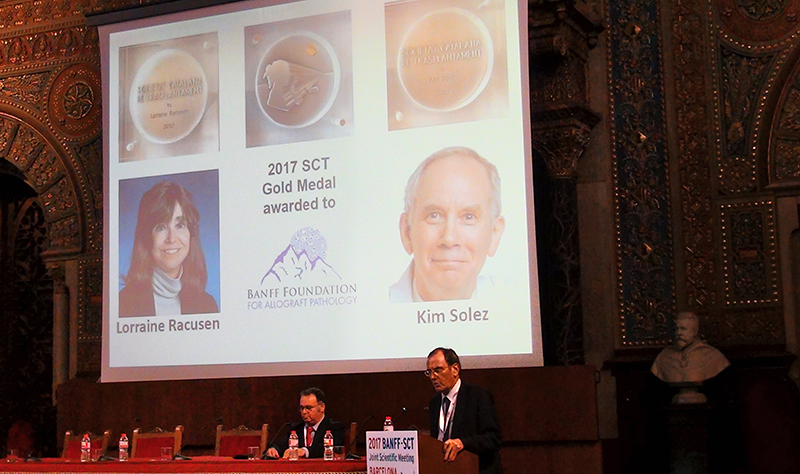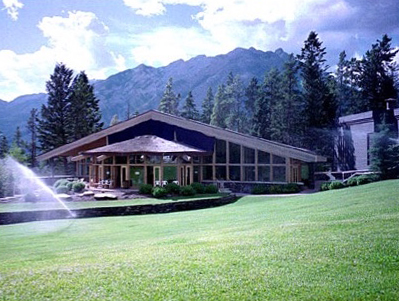
Solez and Racusen received the Gold Medal Award for their exceptional contribution to the field of transplantation. (Photos: Kim Solez)
In the 1980s, there were multiple-and often incompatible-classification systems for pathology and x-ray diagnosis in the transplant sciences. Kim Solez, a University of Alberta pathologist, recognized that inconsistent diagnosis was preventing many transplant anti-rejection drug clinical trials from taking place and there was a need for standardized classifications.
Solez, along with pathologist Lorraine Racusen of Johns Hopkins University, convened a meeting in Banff, Alberta in August 1991, which led to the creation of the first standardized, international classification for biopsies of transplanted kidneys. Meetings in Banff have been held every two years ever since, known in transplant sciences circles simply as the 'Banff meetings' or as the 'Banff process.'
Over the years, the Banff meeting agendas have expanded from kidney transplant pathology to include all solid organs, as well as composite tissue grafts. Reports from the meetings are among the most highly cited articles in the American Journal of Transplantation, the top journal in the field.
By providing a consensus-based definition of transplant rejection, the Banff process was-and continues to be-an important step in developing anti-rejection drugs and improving care for transplant recipients.
"The Banff process is a significant achievement. It is a grassroots, medical community-based process that has had a global impact," said Michael Mengel, Chair of the Department of Pathology and Laboratory Medicine, crediting Solez's consensus building approach for the meetings' success.
"Solez never claimed the content, just facilitated the process and it has prevailed because he didn't take ownership. Consensus is at the heart of the Banff process."
Setting the rules on what defines organ transplant rejection
Prior to the development of the Banff process, it was assumed that clinical trials would be based on the endpoint of graft loss, but there were not enough graft losses to make this practical or effective.
The first Banff meeting started out as an effort to establish what rejection was, so that it could be used in the care of transplant recipients and as an endpoint in clinical trials.
Philip Halloran, U of A transplantation expert, recalls how the Banff meetings were started at a time when a lot of medical, pathology, and x-ray diagnosis lived in the world of opinion.
"Everyone knew what rejection looked like," remembered Halloran. "The problem was that people couldn't say what they were seeing...opinion was all over the place. It was important to set down some rules."
Halloran and colleagues believed that the endpoint should be rejection, which meant that everyone would have to unify their understanding on what rejection was. The first Banff meeting and consensus process allowed for this validation to take place. With a standard definition of rejection agreed-upon, Halloran was able to then take the classification to the Federal Drug Administration (FDA) and move forward with a clinical trial that used the endpoint of biopsy-proven rejection.
Subsequently, all other clinical trials used this new Banff classification as their standard endpoint.
"The Banff process allowed us not just to look after people better, but it also allowed us to develop new drugs that really changed the long-term outcome dramatically for people with organ transplants," reflected Halloran.
Guided by the 'Banff spirit'
The fact that the Banff classification is still a flourishing and ongoing consensus process is notable. In medical consensus generation, there are typically strong egos involved. According to Solez, the Banff process has set the gold standard for the whole area of medical consensus generation.
"We try to reach a point where everyone is happy," explained Solez. "There is no competing standard because every time there was a rebel voice, we invited them in and considered their perspectives. It is important to be flexible and open to other people's superior suggestions in a public forum."
"This special Banff spirit allows us to achieve consensus while maintaining intellectual freedom and staying youthful in our mindset, remaining curious, and avoiding rigidity."
In 1997, the Banff process merged with Cooperative Clinical Trials in Transplantation (CCTT), a transplant pathology entity supported by the American National Institutes of Health, headed by Harvard pathologist Robert Colvin. The classification system that came out of this merging is among the most cited articles in transplantation literature with more than 3,000 citations.
Solez highlights as another key ingredient the relatively small size of the group in attendance at the Banff consensus sessions, usually involving fewer than 150 people, as well as the interdisciplinary nature of the Banff meetings that involved clinical thought leaders like Halloran from the onset.
"Participants have capacity for positive interactions that could never occur in a larger meeting. For young people, the ability to easily talk to well-known leaders in the field is rewarding, and it keeps them coming back time after time. The Banff process is thriving and has a real future," said Solez.
In March 2017, the co-organizers and creators of the Banff meetings, Solez and Racusen, were recognized with the Gold Medal Award from the Catalan Society of Transplantation. The award is presented to "the most outstanding persons in the field of transplantation from around the world, whose work has been exceptionally important for the progress and expansion of transplantation."
